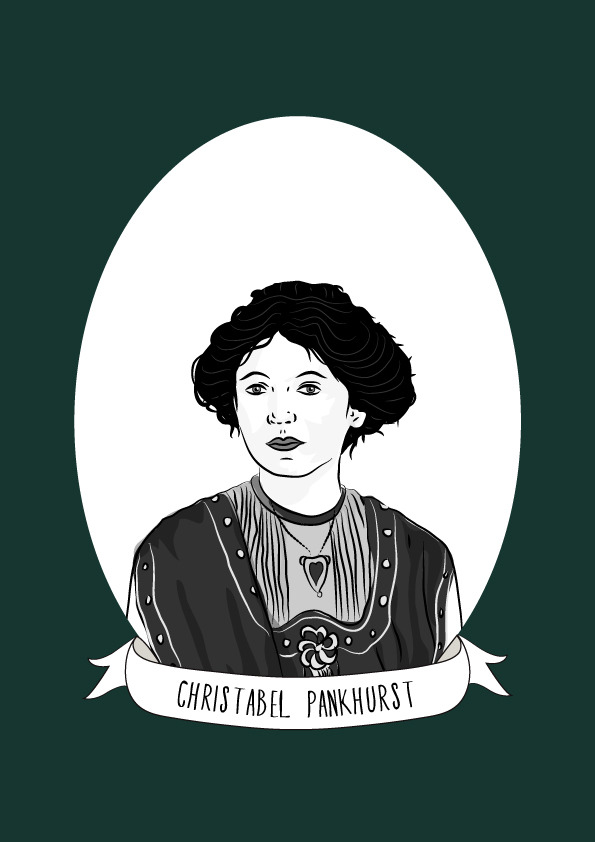Christabel Pankhurst was one of the driving forces of the Suffragette movement, she was a co-founder of the Women’s Social and Political Union (WSPU).
Pankhurst was born in Manchester in 1880. She was the daughter of radical socialist Dr. Richard Pankhurst and women’s suffrage movement leader Emmeline Pankhurst. Her father had been responsible for drafting an amendment to the Municipal Franchise Act of 1869 that led to unmarried women householders being allowed to vote in local elections and served on the Married Women’s Property Committee (1868-1870). He was also he main person responsible for the drafting of the women’s property bill that was passed by Parliament in 1870.
In 1886 the family moved to London, their home became a centre for gatherings of socialists and suffragists and her parents were members of the Fabian Society (a British socialist organisation). Pankhurst was encouraged to attend the meetings and this, along with her parents continued fight for women’s suffrage helped to shape her political views.
In 1901 Pankhurst met Esther Roper and Eva Gore-Booth, members of the National Union of Women’s Suffrage Societies (NUWSS). Pankhurst, her mother and her sister Sylvia were interested in the ideas behind the society and Pankhurst joined their women’s trade union campaign and also became a member of the Independent Labour Party.
In 1903, discouraged by the lack of progress made by the NUWSS due to their insistence that verbal reasoning was a better method of campaigning than direct action Pankhurst and her mother co-founded the Women’s Social and Political Union (WSPU), better known as the Suffragettes.
In October 1905 Pankhurst and Annie Kenney attended a Liberal rally at the Free Trade Hall in Manchester. They asked Winston Churchill and Sir Edward Grey ‘If you are elected, will you do your best to make women’s suffrage a government measure?’ but received no response. The women unfurled a ‘Votes for Women’ banner and were promptly thrown out. They were arrested and charged with assault of the policemen who claimed they’d kicked them. Neither women had the money to pay their fines and were sent to Strangeways prison. The media coverage highlighted the suffragette movement and the membership of the WPSU swelled.
In 1906 Pankhurst graduated in Law from Manchester University, she received honours in her LLB exam but was unable to practice law because of her gender. She moved to London where she worked as the organising secretary of the WSPU. Parliament was refusing to accept the idea of female suffrage and the actions of the Suffragettes became more militant. Pankhurst was jailed in in 1907 and 1909 for her actions and was dubbed the ‘Queen of the Mob’ by the media. She became one of the WPSU’s most powerful speakers, at one time in 1908 speaking to a crowd of 500,000.
In 1910, after protesters were beaten and killed their relatively peaceful demonstrations were replaced with stone throwing, breaking of shop windows and attacking politicians who were known to be against women’s suffrage. Pankhurst’s notoriety led to her becoming a target for the police. Pankhurst and her mother were arrested for promoting the idea that women’s suffrage activists should enter Parliament, she cross-examined the officials in court proceedings and was imprisoned.
From 1912 to 1913, Pankhurst lived in France to escape imprisonment. She continued her part in the WPSU by discussing policy and tactics with Pankhurst with Annie Kenney. They began a campaign to destroy the contents of pillar-boxes, destroying over 5,000 letters. Under Pankhurst’s orders members of the WSPU attempted to burn down the houses of two members of the government who opposed women having the vote.
In 1914 Pankhurst returned to England and spoke at the London Opera House on “The German Peril”. She toured the country giving speeches urging men to join the war effort. Her supporters handed a white feather to every young man they encountered wearing civilian dress. The WPSU newspaper was renamed ‘Britannia’ in 1915 and Pankhurst wrote on against politicians she saw as being soft on war including Sir Edward Grey and Lord Robert Cecil who she referred to as ‘traitors’. ‘Britannia’ became so controversial that it attracted the attention of the police raided its premises more than once.
In 1918 the Representation of the People’s Act introduced women’s suffrage for those over 30 years of age and most of the members of the WPSU felt that the organisation had served its purpose. Pankhurst stood as a Women’s Party candidate in Smethwick but narrowly lost to the Labour Party candidate. She left the UK in 1921 for America, becoming an evangelist in the Second Adventist movement. In the early 1930’s she returned to England was appointed a Dame Commander of the British Empire in 1936. She returned to America in 1939 at the onset of World War II. She died at the age of 77 in 1958 at her home in Santa Monica, California.
